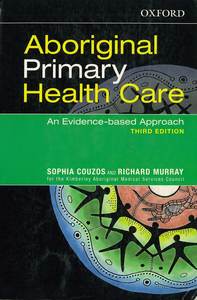Sexually transmitted infections
Skov, S., Murray, R., and Latif, A. (2008) Sexually transmitted infections. In: Couzos, Sophia, and Murray, Richard, (eds.) Aboriginal Primary Health Care: an evidence-based approach. Oxford University Press, South Melbourne, VIC, Australia, pp. 622-673.
![[img]](https://researchonline.jcu.edu.au/7307/2.hassmallThumbnailVersion/7307_Skov_et_al_2008_cover.jpg)
|
Image (JPEG) (Book Cover)
- Cover Image
Download (228kB) |
|
|
PDF (Published Version)
- Published Version
Restricted to Repository staff only |
Abstract
The Aboriginal population in Australia experiences a massive excess of bacterial sexually transmitted infections (STIs) and associated complications including infertility and adverse pregnancy outcomes. This contributes to a high degree of vulnerability to a human immunodeficiency virus (HIV) epidemic. The excess of STIs relates in part to lack of access to screening and treatment services. The development of nucleic acid amplification tests has increased the sensitivity of diagnosis for many STIs and made possible the use of alternative clinical specimens for screening and diagnosis (such as urine, and self-administered vaginal swabs). However, monitoring of antibiotic resistance patterns among N. gonorrhoeae must be supported by continued collection of culture specimens. The evidence for effectiveness of condoms in prevention of infection is good for both HIV and other STIs and promotion of their use remains central to prevention strategies. Increased access to primary health care and comprehensive sexual health programs in the primary health care setting can reduce STI and HIV transmission. Human papillomavirus (HPV) vaccine appears to be highly effective. Vaccines against herpes simplex virus (HSV) show promise but remain developmental. Population-based screening for syphilis, gonorrhoea, and chlamydia can reduce disease prevalence and, in areas of high endemicity, may be a more cost-effective disease control strategy than exhaustive partner notification. Congenital syphilis is a devastating condition that continues to occur regularly and antenatal syphilis screening in the first and third trimester and following delivery should be rigorously implemented in all endemic areas. Antenatal screening for chlamydia and gonorrhoea should also be standard in areas of high endemicity. The syndromic approach simplifies and standardises STI management and is widely recommended. Partner notification remains an important part of STI case management despite a lack of evidence of effectiveness in population disease control. The potential for harm from partner notification should be considered and underscores the need to negotiate partner notification with the patient.
| Item ID: | 7307 |
|---|---|
| Item Type: | Book Chapter (Research - B1) |
| ISBN: | 978-0-19-555138-9 |
| Keywords: | Aboriginal health; sexually tansmitted diseases; STIs |
| Date Deposited: | 01 Feb 2010 01:45 |
| FoR Codes: | 11 MEDICAL AND HEALTH SCIENCES > 1117 Public Health and Health Services > 111701 Aboriginal and Torres Strait Islander Health @ 50% 11 MEDICAL AND HEALTH SCIENCES > 1103 Clinical Sciences > 110309 Infectious Diseases @ 50% |
| SEO Codes: | 92 HEALTH > 9203 Indigenous Health > 920301 Aboriginal and Torres Strait Islander Health - Determinants of Health @ 67% 92 HEALTH > 9201 Clinical Health (Organs, Diseases and Abnormal Conditions) > 920119 Urogenital System and Disorders @ 33% |
| Downloads: |
Total: 338 Last 12 Months: 4 |
| More Statistics |



